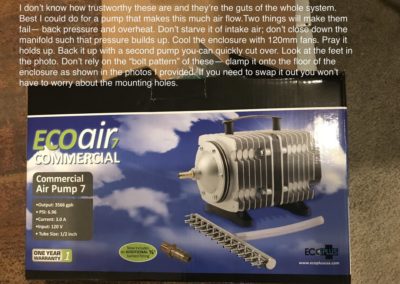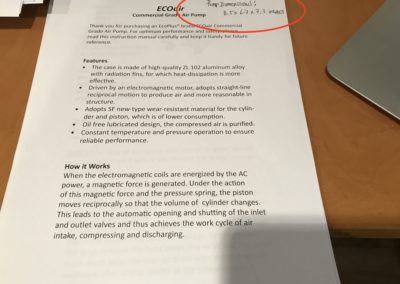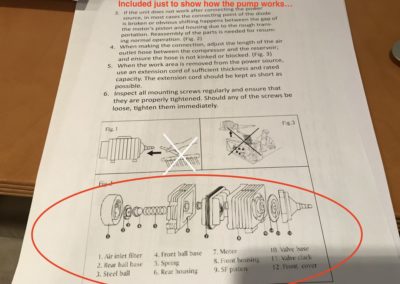Build Rev 2
PumpAs a field ventilator, it cannot be assumed that hospital air will be available. If available, hospital air can be delivered in place of pump air. If not, the Field Vent delivers its own. The pump we selected is a commercial aquarium pump designed for continuous duty over long spans of time. A regional hydroponics vendor told us he has deployed several of these units and operated them continuously for over a year without significant drop in performance. The unit runs on 110VAC and consumes 200 watts of power. Although it is rated at approximately 220 Liters per minute at 6.96 psi, much of that will not be delivered to patients. It will be necessary to test flow and pressure at each manifold and port, as well as bypass air flow. It is critical that air flow from the pump not be cut off, or “deadheaded.” It needs to keep moving air or it may overheat and fail. We are supplying two pumps with every unit, one as a backup. If the backup needs to be used in an emergency, it is not necessary to remove the failed pump from the enclosure. Simply unplug it, and connect the secondary pump (seconds). Move the tubing from the primary pump to the secondary. The patient vent ports will immediately begin receiving air. Then, take the time to connect the secondary pump to the intake filter.
Legal Disclaimer
The content on this website is being released in this manner to maximize the potential public benefit during this urgent need for measures to respond to the COVID-19 crisis, including promoting potential ventilator manufacturing methods.
The content has not been reviewed or approved by the U.S. Food and Drug Administration (FDA). Interested readers are encouraged to contact the FDA and review available FDA materials, including their guidance on ventilators as well as the Department of Health and Human Services (DHHS) declaration of liability immunity for medical countermeasures against COVID-19.
PLEASE NOTE: The content has not been peer reviewed. The Authors make no representations or warranties of any kind (express or implied) relating to accuracy, safety, usefulness, usability, marketability, performance, or otherwise of the content released here. The Authors disclaim all express and implied warranties of merchantability and fitness of the content for a particular purpose, and disclaims all express and implied warranties regarding non-infringement of any patent, copyright, trademark, or other rights of third parties in the content or use of the content, or in the making, using, or selling products or services by any person or entity.
People or entities attempting to use the content in any way, including creating products or offering services, assume all risk and responsibility related to those uses, including all legal and regulatory compliance, safety, efficacy, performance, design, marketability, title, and quality. The Authors assume no liability related to the actions of third parties and in respect of any infringement of any patent, copyright, or other right of third parties.
The content has not been used in testing with humans at this time.
The Authors’ names and logos are trademarks or other exclusive property of the Authors. Readers of the content shall not use the name or logo of any Author in any way for publicity, advertising, or other commercial purposes, including linked to the reader’s products or services. Readers of the content shall not make statements or representations that, in Author’s sole judgment, deliberately or inadvertently claim, suggest, or give the appearance or impression of a relationship with or endorsement by that Author.
The Authors are proud of their affiliation with the University of Colorado as alumni and, in the case of Dr. Thomas Greany, as a professor at the Anschutz Medical Campus. The Authors express their appreciation to the University of Colorado for its support of this project.



